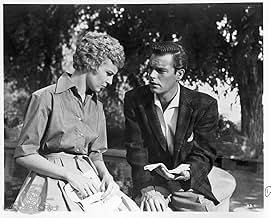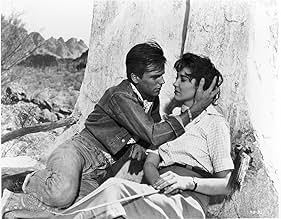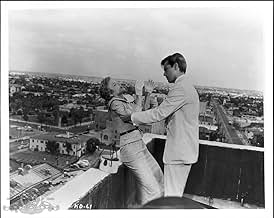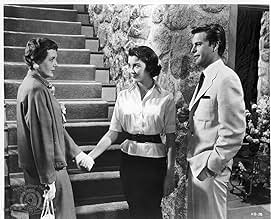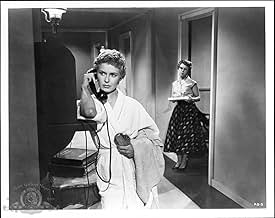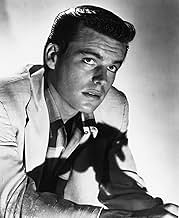NOTE IMDb
6,7/10
4,7 k
MA NOTE
Ajouter une intrigue dans votre langueA ruthless college student resorts to murder in an attempt to marry an heiress.A ruthless college student resorts to murder in an attempt to marry an heiress.A ruthless college student resorts to murder in an attempt to marry an heiress.
- Réalisation
- Scénario
- Casting principal
Albert Cavens
- Restaurant Patron
- (non crédité)
Robert Ivers
- Student at Murder Scene
- (non crédité)
Mickey Martin
- Student
- (non crédité)
Joe McGuinn
- Chemistry Professor
- (non crédité)
Edwin Rochelle
- Restaurant Patron
- (non crédité)
Jack Stoney
- Policeman
- (non crédité)
Avis à la une
This Cinemascope Technicolor murder drama from 1955 is a great looking film with perfect 50s visuals to carry it well in 2008. In retrospect, I can see the source for both PEEPING TOM and PSYCHO both in 1960 offering the 'shocking' image of a square cut handsome young man as a cruel killer. Of course that idea alone is really a flip on MONSIEUR VERDOUX with Chaplin as the ageing dandy/ dapper killer and even the comedy ARSENIC AND OLD LACE again with the least suspecting type as killers. This version of KISS now-days is reflected in MR RIPLEY too. While it is not up the caliber of that film either, these films all form a group of murder mysteries depicting unassuming types revealed to be murderers. A KISS BEFORE DYING has the very handsome Robert Wagner and equally good looking Jeffrey Hunter pitched front and center for what must have been wild female audience reaction. One scene late in the film set in the desert features Wagner in the tightest jeans imaginable looking like a gay denim version of James Dean. It is all a bit silly in its storyline (university campus killer and rich girl family dramas) but visually it is a real 50s treat. Remade clumsily as a Matt Dillon thriller in 1991, this really is the better version completely because of the great looking cast (incl Joanne Woodward and Mary Astor) and the immensely enjoyable Cinemascope 50s set design and art direction.
Gerd Oswald's excellent film was his first and perhaps his best, as well as arguably providing Robert Wagner's finest hour. Like Tony Curtis was to do a decade later in The Boston Strangler (1968), screen pretty-boy Wagner took the role of the cunning sociopath Bud Corliss partly in an attempt to prove he could act darker parts than his fans had been used to. Taken from a novel by Ira Lewin (whose work also inspired Rosemary's Baby, The Stepford Wives and The Boys From Brazil) the film is a well mounted, taut B-movie, albeit shot widescreen in Deluxe Color by no less a talent than Lucien Ballard, who later went on to do sterling work for such directors as Sam Peckinpah. His crisp cinematography reveals a land dressed in bright open colours, where American meritocracy is secure and, on the surface at least, all seems right. As such, it carries echoes of contemporaneous romantic fluff such as Pillow Talk as well as some of the late, luscious films by Douglas Sirk.
Watching A Kiss Before Dying however is a wholly different experience from Sirk's ironic stagings of smug Eisenhower society, this despite the presence of a clean-cut, pipe smoking Professor Grant (Jeffrey Hunter). His academic character, perhaps the least convincing in the film, is more of a straightforward stereotype than the German director would ever manage, but acts as a counterweight to Corliss' callous misuse of his own good looks and intelligence. Self-satisfied and entirely free of remorse, the student is thus a much more modern figure than the academic, and his presence undermines Grant's rather ineffectual 1950s' decency. Oswald's minor classic focuses on this cold heart - an individual whose ambition, and eventual downfall, might have found its roots in such earlier films as Ulmer's Ruthless (1948), as well as it anticipates some of Hitchcock's work.
Although it is only mentioned briefly, Corliss has obviously been affected by his experience in the war ("It's my side where I was wounded," he says at one point, and one of the first things we see are military photographs.) The implication, typical of noir, is that the conflict has affected his mental state. Corliss is a promising student, who lives alone with his mother (Mary Astor). As the film begins he is learning of the unexpected pregnancy of his girlfriend Dorothy (Joanne Woodward). Despite his outward concerns and pledge to marry the woman, he secretly plots to dispose of her before moving on to her sister Ellen (Virginia Leith). At the same time Ellen suspects that her sister's eventual suicide was not entirely as it seemed and does some investigating with the help of the obliging Grant...
As others have noticed, there are certain intriguing similarities between A Kiss Before Dying and the plot of Psycho which came four years later: both films begin with furtive discussion of lovers discussing the implications of illicit sex, go on to feature the premature demise of a blonde and then, in a second half, the investigation of mystery by a determined female relative. There are echoes of Vertigo (1958) too in the dangerous heights of City Hall where Budd finally commits his heinous crime, and more than a taste of Hitchcock in some of the of the suspenseful machinations of the plot - most especially in the chemistry supply room scene where Corliss furtively steals his poisons, or during the tense roof scene. It's somehow apt that Mary Astor, who played the calculating Brigid O'Shaughnessy in The Maltese Falcon (1941), should be cast as Corliss' mother in the present film - although even she is much reduced and manipulated by him, facing a final humiliation on the doorstep of the Kingship residence. Her son is at heart a ruthless social climber, for whom the earlier 'problem' posed by Dorothy was just another obstacle to his inevitable rise to social success, just as his mother's dress sense is then another. As a schemer he leaves little to chance, as is evidenced by his careful arrangement of events in the first half of the film and detailed knowledge of the Kingship mining operation he casually reveals at the close. When he is undone, it is by misfortune rather than carelessness - a fact that makes his success all the more frightening as it is compromised by chain of chance more than anything else. As Corliss, Wagner is entirely convincing in a ruthless part that, at first sight, would have been ideal casting for Dennis Hopper. Beneath the familiar clean-cut image lies a calculating, black heart, and he suggests this by effective mannerisms, such as the throwaway, amoral shrug reflected in the jeweller's shop window at the end of his second meeting with Dorothy, or by holding his arms high and clear, as if in supplication to his own genius, as she makes her final descent. Years down the line, after the amiable dross of such later work as Hart To Hart (1980-5), it is a shock to see the actor create such an impact in what was a unique role for him.
Oswald's direction is frequently distinguished by the use of long takes: the first scene for instance, which contains a fair chunk of dialogue, consists just of a pan over some photographs and one other extended set up. Part of this can be put down to necessary economies of shooting. In some scenes, especially those alone between Corliss and Dorothy, the refusal to cut away acts as if to trap the participants in their own moral universe, while the unflinching lens demands that the viewer make judgement. (There are sly visual jokes contained within shots too, as when at the conclusion of Corliss' second meeting at the sports ground, after her 'trip' down the bleachers, he is framed under a 'speed kills' road sign, or when Corliss and Ellen later flirt and in the wrap up shot the camera reveals they have been chatting under a tombstone-shaped rock.) This is not altogether to the film's advantage; in the middle section of the film, when Corliss is largely absent, some scenes drag a little. Occasionally Oswald changes pace, such as when he uses a fast dolly-in on the suicide note. But one senses that here the exposition would have benefited from shorter cutting, as the earnest Ellen and nice-but-dull Grant are not a very dynamic couple when alone on screen. However this is a minor quibble in a film that relishes a broad mise-en-scène, typical of 1950s' melodrama.
George Macreedy, who plays Leo Kingship, gives excellent, grouchy support. It is his character that undergoes the only real metamorphosis in the film. His daughter of course learns that things are not really what they seem, as she discovers what Budd is really like under the tailored surface. Kingship Senior's education is far more profound, as he almost loses her through his over-protectiveness and intransigence. In one respect he is like Corliss: both have seen the nexus of family ties fray, leading to personality problems. At the end of the film, as he escorts his daughter away from the last encounter, Kingship does so more in sorrow than with the anger he would have earlier displayed. Here, as events take a final turn, the desolation of the mines provides a physical corollary for the stark moral drama being played out between the principals.
A Kiss Before Dying was remade by James Dearden in 1991, an unsatisfactorily production that entirely missed the period intensity and compulsiveness of the original. The DVD offers little other but a trailer, although the widescreen transfer is splendid.
Watching A Kiss Before Dying however is a wholly different experience from Sirk's ironic stagings of smug Eisenhower society, this despite the presence of a clean-cut, pipe smoking Professor Grant (Jeffrey Hunter). His academic character, perhaps the least convincing in the film, is more of a straightforward stereotype than the German director would ever manage, but acts as a counterweight to Corliss' callous misuse of his own good looks and intelligence. Self-satisfied and entirely free of remorse, the student is thus a much more modern figure than the academic, and his presence undermines Grant's rather ineffectual 1950s' decency. Oswald's minor classic focuses on this cold heart - an individual whose ambition, and eventual downfall, might have found its roots in such earlier films as Ulmer's Ruthless (1948), as well as it anticipates some of Hitchcock's work.
Although it is only mentioned briefly, Corliss has obviously been affected by his experience in the war ("It's my side where I was wounded," he says at one point, and one of the first things we see are military photographs.) The implication, typical of noir, is that the conflict has affected his mental state. Corliss is a promising student, who lives alone with his mother (Mary Astor). As the film begins he is learning of the unexpected pregnancy of his girlfriend Dorothy (Joanne Woodward). Despite his outward concerns and pledge to marry the woman, he secretly plots to dispose of her before moving on to her sister Ellen (Virginia Leith). At the same time Ellen suspects that her sister's eventual suicide was not entirely as it seemed and does some investigating with the help of the obliging Grant...
As others have noticed, there are certain intriguing similarities between A Kiss Before Dying and the plot of Psycho which came four years later: both films begin with furtive discussion of lovers discussing the implications of illicit sex, go on to feature the premature demise of a blonde and then, in a second half, the investigation of mystery by a determined female relative. There are echoes of Vertigo (1958) too in the dangerous heights of City Hall where Budd finally commits his heinous crime, and more than a taste of Hitchcock in some of the of the suspenseful machinations of the plot - most especially in the chemistry supply room scene where Corliss furtively steals his poisons, or during the tense roof scene. It's somehow apt that Mary Astor, who played the calculating Brigid O'Shaughnessy in The Maltese Falcon (1941), should be cast as Corliss' mother in the present film - although even she is much reduced and manipulated by him, facing a final humiliation on the doorstep of the Kingship residence. Her son is at heart a ruthless social climber, for whom the earlier 'problem' posed by Dorothy was just another obstacle to his inevitable rise to social success, just as his mother's dress sense is then another. As a schemer he leaves little to chance, as is evidenced by his careful arrangement of events in the first half of the film and detailed knowledge of the Kingship mining operation he casually reveals at the close. When he is undone, it is by misfortune rather than carelessness - a fact that makes his success all the more frightening as it is compromised by chain of chance more than anything else. As Corliss, Wagner is entirely convincing in a ruthless part that, at first sight, would have been ideal casting for Dennis Hopper. Beneath the familiar clean-cut image lies a calculating, black heart, and he suggests this by effective mannerisms, such as the throwaway, amoral shrug reflected in the jeweller's shop window at the end of his second meeting with Dorothy, or by holding his arms high and clear, as if in supplication to his own genius, as she makes her final descent. Years down the line, after the amiable dross of such later work as Hart To Hart (1980-5), it is a shock to see the actor create such an impact in what was a unique role for him.
Oswald's direction is frequently distinguished by the use of long takes: the first scene for instance, which contains a fair chunk of dialogue, consists just of a pan over some photographs and one other extended set up. Part of this can be put down to necessary economies of shooting. In some scenes, especially those alone between Corliss and Dorothy, the refusal to cut away acts as if to trap the participants in their own moral universe, while the unflinching lens demands that the viewer make judgement. (There are sly visual jokes contained within shots too, as when at the conclusion of Corliss' second meeting at the sports ground, after her 'trip' down the bleachers, he is framed under a 'speed kills' road sign, or when Corliss and Ellen later flirt and in the wrap up shot the camera reveals they have been chatting under a tombstone-shaped rock.) This is not altogether to the film's advantage; in the middle section of the film, when Corliss is largely absent, some scenes drag a little. Occasionally Oswald changes pace, such as when he uses a fast dolly-in on the suicide note. But one senses that here the exposition would have benefited from shorter cutting, as the earnest Ellen and nice-but-dull Grant are not a very dynamic couple when alone on screen. However this is a minor quibble in a film that relishes a broad mise-en-scène, typical of 1950s' melodrama.
George Macreedy, who plays Leo Kingship, gives excellent, grouchy support. It is his character that undergoes the only real metamorphosis in the film. His daughter of course learns that things are not really what they seem, as she discovers what Budd is really like under the tailored surface. Kingship Senior's education is far more profound, as he almost loses her through his over-protectiveness and intransigence. In one respect he is like Corliss: both have seen the nexus of family ties fray, leading to personality problems. At the end of the film, as he escorts his daughter away from the last encounter, Kingship does so more in sorrow than with the anger he would have earlier displayed. Here, as events take a final turn, the desolation of the mines provides a physical corollary for the stark moral drama being played out between the principals.
A Kiss Before Dying was remade by James Dearden in 1991, an unsatisfactorily production that entirely missed the period intensity and compulsiveness of the original. The DVD offers little other but a trailer, although the widescreen transfer is splendid.
According to Alicia Malone, the beautiful and intelligent host at tcm, "A Kiss Before Dying" is considered by Joanne Woodward to be not only her worst picture but the worst picture ever made by Hollywood. Oh c'mon, Joanne, considering some of the turkeys that I have seen with you and your late husband, Paul Newman, you can't possibly be serious. Don't get me wrong. Everyone is entitled to a living, and it's nice work if you can get it. At any rate, considering that Dore is supposed to be a bit of a whining nebbish, Joanne plays the part quite well.
I couldn't help from comparing this story, originating from Ira Levin's novel, to that of Theodore Dreiser's "An American Tragedy" which was adapted to the silver screen as "A Place in the Sun". While Levin's and Dreiser's stories both center on the very determined ambitions of two young men from very modest, if not impoverished, backgrounds, the big difference is that George Eastman (Montgomery Clift) in "Place in the Sun" does not deliberately kill the woman he impregnates. He only WANTS to kill her in the worst way and then does nothing to help her when she, herself, manages to overturn their rowboat on Loon Lake. This significantly distinguishes Eastman from Bud Corliss (Robert Wagner), who, to me, is far less sympathetic and far more depraved than George. The scenes at the closed marriage license offices in both films are also very similar.
The entire cast is excellent, and I would argue that this is among Mr. Wagner's best roles as an unlikely psychopathic murderer. Noteworthy is his brief scene with Mary Astor when he scolds her, his mother, for her wardrobe choice moments before he introduces her to his wealthy girlfriend's family. This one scene defines his character and gives us an important glimpse of at least some of the circumstances behind his motivation. Are the short haircuts of both Mom and Dore a mere coincidence, or is there much more lurking behind that similarity? Mary Astor, an outstanding actor, has always contributed greatly to all of the movies in which I have seen her, including "Act of Violence", "Dodsworth", and "The Maltese Falcon", only a few that immediately come to mind. George Macready, including his distinctively resonant voice, is another seasoned professional whose appearance is a very welcome bonus here. I thought that Virginia Lieth acts very decently, and she looks beautiful, so I don't know why I have never seen her in any other film.
The technicolor photography of cinematographer Lucien Ballard on location in and around Tucson, Arizona, including the campus of the University of Arizona, is exceptional. There is a noticeable crispness to it as it captures the unique architecture and natural surroundings of 1956 Tucson, days that only survive as they are archived by films such as this. Note the copper colored Thunderbird that Dore Kingship drives as well as the corded telephone and the swimming pool ladders of the same color. Someone had a barrel of fun making this picture.
As is the case with any film, there are some peculiar instances, including the reluctance of Dwight Powell at least to attempt to fight for his life. And where is the truck driver at the end? I expected him to appear immediately at the scene instead of hiding in his cab until the police arrive. And does Bud actually push Ellen out of the path of danger, as I believe he does? Also, if Bud's service during the Korean War is a factor behind his behavior, this should have been developed more as it should have but wasn't in the case of George Loomis (Joseph Cotton) in "Niagara", another favorite of mine from the same era.
I couldn't help from comparing this story, originating from Ira Levin's novel, to that of Theodore Dreiser's "An American Tragedy" which was adapted to the silver screen as "A Place in the Sun". While Levin's and Dreiser's stories both center on the very determined ambitions of two young men from very modest, if not impoverished, backgrounds, the big difference is that George Eastman (Montgomery Clift) in "Place in the Sun" does not deliberately kill the woman he impregnates. He only WANTS to kill her in the worst way and then does nothing to help her when she, herself, manages to overturn their rowboat on Loon Lake. This significantly distinguishes Eastman from Bud Corliss (Robert Wagner), who, to me, is far less sympathetic and far more depraved than George. The scenes at the closed marriage license offices in both films are also very similar.
The entire cast is excellent, and I would argue that this is among Mr. Wagner's best roles as an unlikely psychopathic murderer. Noteworthy is his brief scene with Mary Astor when he scolds her, his mother, for her wardrobe choice moments before he introduces her to his wealthy girlfriend's family. This one scene defines his character and gives us an important glimpse of at least some of the circumstances behind his motivation. Are the short haircuts of both Mom and Dore a mere coincidence, or is there much more lurking behind that similarity? Mary Astor, an outstanding actor, has always contributed greatly to all of the movies in which I have seen her, including "Act of Violence", "Dodsworth", and "The Maltese Falcon", only a few that immediately come to mind. George Macready, including his distinctively resonant voice, is another seasoned professional whose appearance is a very welcome bonus here. I thought that Virginia Lieth acts very decently, and she looks beautiful, so I don't know why I have never seen her in any other film.
The technicolor photography of cinematographer Lucien Ballard on location in and around Tucson, Arizona, including the campus of the University of Arizona, is exceptional. There is a noticeable crispness to it as it captures the unique architecture and natural surroundings of 1956 Tucson, days that only survive as they are archived by films such as this. Note the copper colored Thunderbird that Dore Kingship drives as well as the corded telephone and the swimming pool ladders of the same color. Someone had a barrel of fun making this picture.
As is the case with any film, there are some peculiar instances, including the reluctance of Dwight Powell at least to attempt to fight for his life. And where is the truck driver at the end? I expected him to appear immediately at the scene instead of hiding in his cab until the police arrive. And does Bud actually push Ellen out of the path of danger, as I believe he does? Also, if Bud's service during the Korean War is a factor behind his behavior, this should have been developed more as it should have but wasn't in the case of George Loomis (Joseph Cotton) in "Niagara", another favorite of mine from the same era.
A scheming college guy, played by a youthful Robert Wagner, tries to marry into wealth. Complications result in murder. Because of the murder angle, and because the plot centers on Wagner's sly and cunning character, the film reminds me a little of "Dial M For Murder". But, to its credit, "A Kiss Before Dying" has a darker, more brooding, noir-like quality, helped along by a 50's music score that is jazzy and slightly mournful.
Wagner's acting, if not Oscar-worthy, is at least acceptable. But Jeffrey Hunter is miscast, and therefore not convincing, as the pipe-smoking professor/detective. And Joanne Woodward gives a clinging, and altogether too whiny, performance, as the damsel in distress. A couple of interesting, if somewhat implausible, plot twists add impact to the screenplay. The film's conclusion, however, is predictable and just a tad melodramatic.
Overall, "A Kiss Before Dying" comes across as a stylish, very 1950ish, wanna-be classic. It doesn't quite succeed, but is nonetheless worth watching at least once, especially for viewers who like dark, brooding, twist-laden thrillers.
Wagner's acting, if not Oscar-worthy, is at least acceptable. But Jeffrey Hunter is miscast, and therefore not convincing, as the pipe-smoking professor/detective. And Joanne Woodward gives a clinging, and altogether too whiny, performance, as the damsel in distress. A couple of interesting, if somewhat implausible, plot twists add impact to the screenplay. The film's conclusion, however, is predictable and just a tad melodramatic.
Overall, "A Kiss Before Dying" comes across as a stylish, very 1950ish, wanna-be classic. It doesn't quite succeed, but is nonetheless worth watching at least once, especially for viewers who like dark, brooding, twist-laden thrillers.
Oh, how to resolve the age-old problem of accidentally getting your girlfriend preggers? Well, if you're a good-looking, psychopathic college boy, as portrayed by Robert Wagner in the 1956 thriller "A Kiss Before Dying," the answer is fairly simple: Just knock her off and hope for the best...and pray that her snoopy sister won't start nosing around! Anyway, that's the setup for what turns out to be in essence a poor man's "A Place in the Sun" (1951), but nevertheless a film that remains quite entertaining in its own right. Based on an Ira Levin novel, directed by cult favorite Gerd Oswald, and featuring beautiful, wide-screen color filming (shown to good advantage on the DVD that I just watched), the film certainly does impress. Joanne Woodward comes off very sympathetically here in her third film, and supporting players Mary Astor (a 50-year-old redhead in this picture), George Macready (less hissable than usual) and Jeffrey Hunter (who will ALWAYS be Capt. Pike to me!) are all very fine. But Wagner certainly does steal the show as the pretty-boy whacko. Storywise, I'd say that the plot is a wee bit on the far-fetched side, but never absurdly so, and that most viewers will easily foresee how Wagner will slip up in the end. Still, the film remains suspenseful throughout and concludes most satisfactorily. Strange that the "abortion" word is never brought up, though. Could Wagner's character be a pro-lifer who's into murder? He wouldn't be the first!
Le saviez-vous
- AnecdotesThe producers had to fight the Production Code office, or what was left of it by this time, to get the word "pregnant" into the film. Even then, the word was deleted in some parts of the country by local censors. The novel was further bowdlerized by having no discussion in the film between Bud and Dorothy about the possibility of her having an abortion, and the pills Bud gives her are said by him to be vitamins and are in fact simply poison to kill her - whereas in the novel they are intended to induce a termination of pregnancy.
- GaffesNear the end, Gordon is riding to the mine in a Cadillac limousine that has air conditioning, as indicated by small air scoops on both sides behind the back doors. The next shots (after the accident) show a different Cadillac without them. Cars of this era with factory installed air conditioning had half of the system in the trunk, requiring outside air via those little air scoops.
- Citations
Bud Corliss: It's not right.
Dorothy Kingship: What?
Bud Corliss: For anyone to love somebody as much as I love you.
- ConnexionsReferenced in Living Single: A Kiss Before Lying (1993)
Meilleurs choix
Connectez-vous pour évaluer et suivre la liste de favoris afin de recevoir des recommandations personnalisées
Détails
- Durée1 heure 34 minutes
- Couleur
- Rapport de forme
- 2.35 : 1
Contribuer à cette page
Suggérer une modification ou ajouter du contenu manquant



